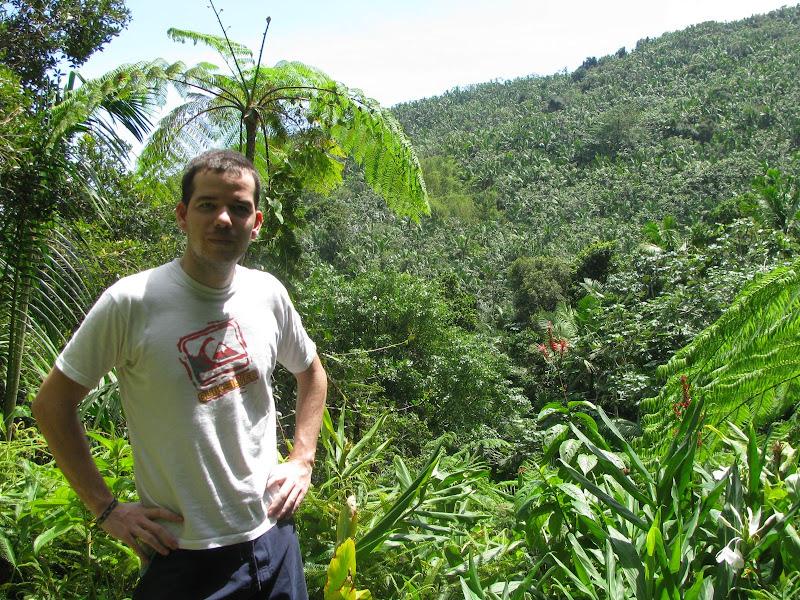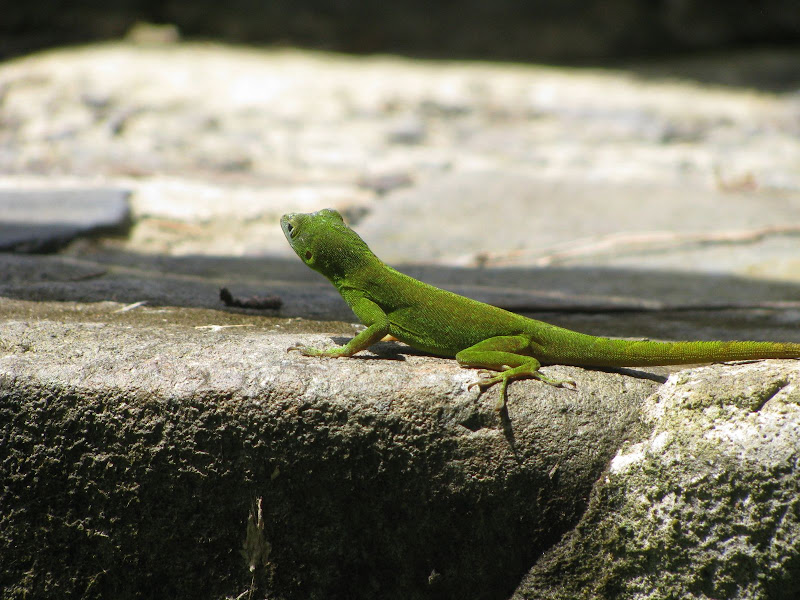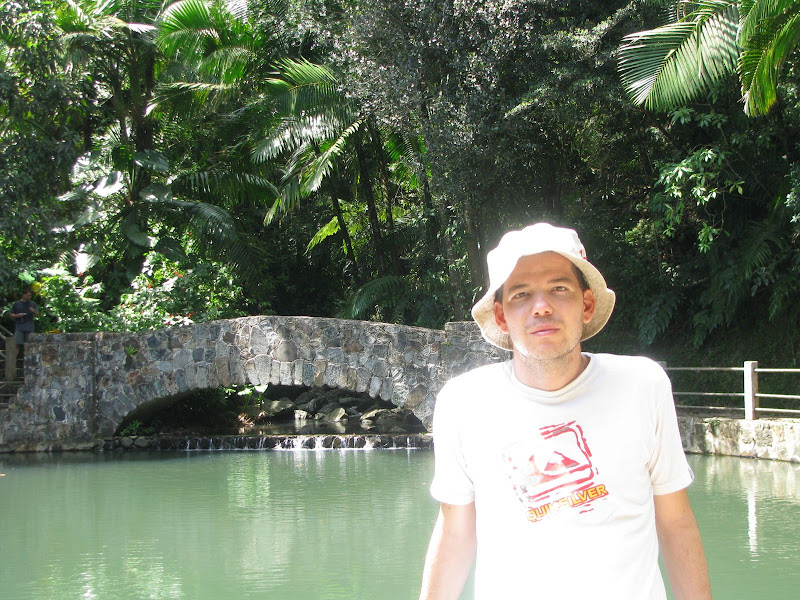El Yunque National Forest, formerly known as the Luquillo National Forest, and the Caribbean National Forest, is a forest located in northeastern Puerto Rico. It is the only tropical rain forest in the United States. The forest is commonly known as El Yunque, which may be attribut ed to either a Spanish approximation of the aboriginal Taino word yu-ke which means "white lands", or the word anvil, which means yunque in Spanish. The second-tallest mountain within El Yunque is also named El Yunque. El Yunque National Rainforest is located on the slopes of the Sierra de Luquillo Mountains and it encompasses 28,000 acres (43.753 mi² or 113.32 km²) of land, making it the largest block of public land in Puerto Rico. El Toro, the highest mountain peak in the forest rises 1,065 meters (3,537 ft) above sea level. Ample rainfall (over 200 inches a year in some areas) creates a jungle-like setting - lush foliage, crags, waterfalls and rivers are a prevalent scene. The forest has a number of trails from where the jungle-like territory's flora and fauna can be appreciated.
ed to either a Spanish approximation of the aboriginal Taino word yu-ke which means "white lands", or the word anvil, which means yunque in Spanish. The second-tallest mountain within El Yunque is also named El Yunque. El Yunque National Rainforest is located on the slopes of the Sierra de Luquillo Mountains and it encompasses 28,000 acres (43.753 mi² or 113.32 km²) of land, making it the largest block of public land in Puerto Rico. El Toro, the highest mountain peak in the forest rises 1,065 meters (3,537 ft) above sea level. Ample rainfall (over 200 inches a year in some areas) creates a jungle-like setting - lush foliage, crags, waterfalls and rivers are a prevalent scene. The forest has a number of trails from where the jungle-like territory's flora and fauna can be appreciated.
The forest region was initially set aside in 1876 by the King Alfonso XII of Spain, and represents one of the oldest reserves in the Western Hemisphere. It was established as the Luquillo Forest Reserve on 17 January 1903 by the General Land Office with 65,950 acres (266.9 km2), and became a National Forest in 1906. It was renamed Caribbean National Forest on 4 June 1935. It is home to over 200 species of trees and plants, 23 of which are found nowhere else. The critically endangered Puerto Rican Amazon (Amazona vittata), with an estimated wild population of 30 individuals, occurred exclusively in this forest until 19 N ovember 2006, when another wild population was released by the Department of Natural Resources in the municipality of Utuado's Rio Abajo State Forest.
ovember 2006, when another wild population was released by the Department of Natural Resources in the municipality of Utuado's Rio Abajo State Forest.
An Executive Order signed by President George W. Bush on 2 April 2007 changed the name of the Caribbean National Forest to El Yunque National Forest, better reflecting the cultural and historical feelings of the Puerto Rican people. Because Puerto Rico is south of the Tropic of Cancer, it has a tropical climate. There is no distinct wet or dry season in the El Yunque; it rains year round. The temperature and length of daylight remain fairly constant throughout the year. All of these factors provide a year-round growing season.
Typical yearly rainfall can be up to 6 m (240 inches) per year, which constitutes more than 380,000,000 m³ (100 billion US gallons) spread over the forest. The forest contains hundreds of species of trees, orchids, plants, and a few animals. You will hear the Coqui frogs and see large snails as they are enjoying the moisture of the forest. The rain helps to create the perfect ecosystem for the frogs and snails and some other creatures in the habitat. You will also hear many birds singing as you walk the trails.
El Yunque is composed of four different forest vegetation areas: Tabonuco Forest, Palo Colorado Forest, Sierra Palm Forest, and Dwarf Forest. El Yunque is als o renowned for its unique Taíno petroglyphs.
o renowned for its unique Taíno petroglyphs.
Its ecosystem is specifically surveyed by the Management Team of Ecosystems, which is led by Pedro Rios. Due to its location in the North Eastern part of Puerto Rico the incoming trade winds from the Atlantic Ocean bash into the mountains, leading to an excess of rainfall registered at about 6m (240 inches) per year "About the Forest". This process is called the orographic lift and accounts for the intense rainfall and constant cloud presence in this mountainous region. This constant cloud cover and persistent winds produced by the adiabatic process of air particles rushing up through the mountainside has affected the morphology of El Yunque, but the most effect has been on the Bosque Enano or the Dwarf Forest
The forest region was initially set aside in 1876 by the King Alfonso XII of Spain, and represents one of the oldest reserves in the Western Hemisphere. It was established as the Luquillo Forest Reserve on 17 January 1903 by the General Land Office with 65,950 acres (266.9 km2), and became a National Forest in 1906. It was renamed Caribbean National Forest on 4 June 1935. It is home to over 200 species of trees and plants, 23 of which are found nowhere else. The critically endangered Puerto Rican Amazon (Amazona vittata), with an estimated wild population of 30 individuals, occurred exclusively in this forest until 19 N
An Executive Order signed by President George W. Bush on 2 April 2007 changed the name of the Caribbean National Forest to El Yunque National Forest, better reflecting the cultural and historical feelings of the Puerto Rican people. Because Puerto Rico is south of the Tropic of Cancer, it has a tropical climate. There is no distinct wet or dry season in the El Yunque; it rains year round. The temperature and length of daylight remain fairly constant throughout the year. All of these factors provide a year-round growing season.
Typical yearly rainfall can be up to 6 m (240 inches) per year, which constitutes more than 380,000,000 m³ (100 billion US gallons) spread over the forest. The forest contains hundreds of species of trees, orchids, plants, and a few animals. You will hear the Coqui frogs and see large snails as they are enjoying the moisture of the forest. The rain helps to create the perfect ecosystem for the frogs and snails and some other creatures in the habitat. You will also hear many birds singing as you walk the trails.
El Yunque is composed of four different forest vegetation areas: Tabonuco Forest, Palo Colorado Forest, Sierra Palm Forest, and Dwarf Forest. El Yunque is als
Its ecosystem is specifically surveyed by the Management Team of Ecosystems, which is led by Pedro Rios. Due to its location in the North Eastern part of Puerto Rico the incoming trade winds from the Atlantic Ocean bash into the mountains, leading to an excess of rainfall registered at about 6m (240 inches) per year "About the Forest". This process is called the orographic lift and accounts for the intense rainfall and constant cloud presence in this mountainous region. This constant cloud cover and persistent winds produced by the adiabatic process of air particles rushing up through the mountainside has affected the morphology of El Yunque, but the most effect has been on the Bosque Enano or the Dwarf Forest
You have read this article with the title Yunque National Forest, Puerto Rico. You can bookmark this page URL http://oinsweden.blogspot.com/2011/07/yunque-national-forest-puerto-rico.html. Thanks!
Write by:
AN - Tuesday, July 26, 2011






.jpg)



Comments "Yunque National Forest, Puerto Rico"
Post a Comment